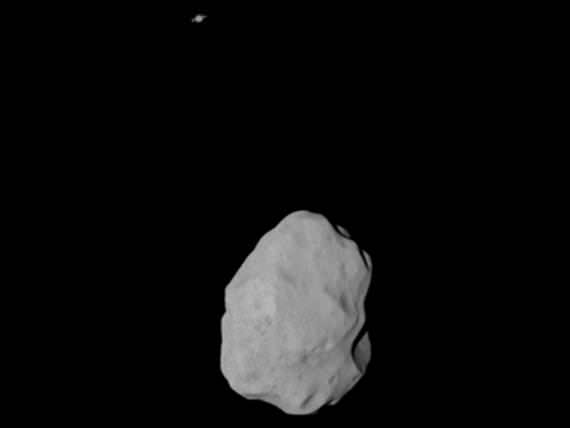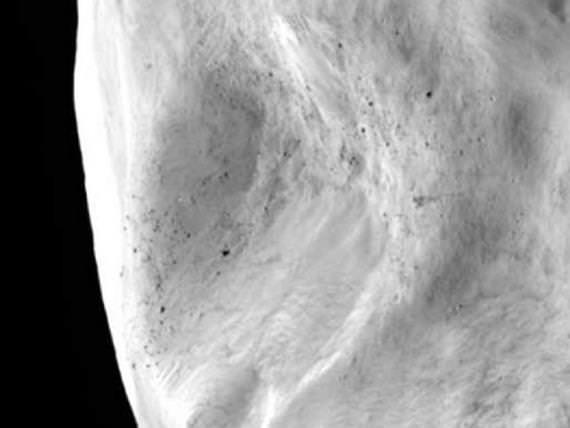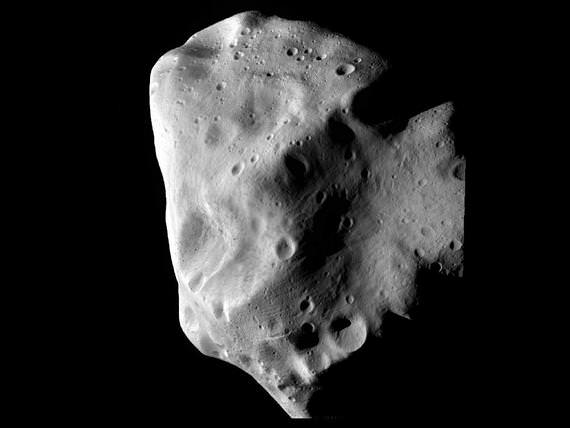[/caption]
Over the weekend, the Rosetta spacecraft flew by asteroid Lutetia, returning the first close up images of this battered, cratered body. By all accounts, the flyby was a spectacular success with Rosetta performing faultlessly. Closest approach took place at 16:10 GMT on July 10, at a distance of 3,162 km (1964 miles). The images show that Lutetia has been on the receiving end of many impacts during its 4.5 billion years of existence. As Rosetta drew close, a giant bowl-shaped depression stretching across much of the asteroid rotated into view. The images confirm that Lutetia is an elongated body, with its longest side around 130 km (80 miles).
“I think this is a very old object. Tonight we have seen a remnant of the Solar System’s creation,” said Holger Sierks, principal investigator for the spacecraft’s OSIRIS instrument, which combines a wide angle and a narrow angle camera. At closest approach, details down to a scale of 60 meters (see below) can be seen over the entire surface of Lutetia.

Rosetta raced past the asteroid at 15 km/s completing the flyby in just a minute. But the cameras and other instruments had been working for hours and in some cases days beforehand, and will continue afterwards. Shortly after closest approach, Rosetta began transmitting data to Earth for processing, and the Rosetta team will surely release more details in the coming days and weeks.
In the meantime, enjoy this wonderful poem composed by space poet laureate Stu Atkinson.
Lutetia in the Light
For all these years you were merely
A smear of light through our telescopes
On the clearest, coldest night; a hint
Of a glint, just a few pixels wide
On even your most perfectly-framed portraits.
But now, now we see you!
Swimming out of the dark – a great
Stone shark, your star-tanned skin pitted
And pocked, scarred after aeons of drifting
Silently through the endless ocean of space.
Here on Earth our faces lit up as we saw
You clearly for the first time; eyes wide
With wonder we traced the strangely familiar
Grooves raked across your sides,
Wondering if Rosetta had doubled back to Mars
And raced past Phobos by mistake –
Then you were gone, falling back into the black,
Not to be seen by human eyes again for a thousand
Blue Moons or more. But we know you now,
We know you; you’ll never be just a speck of light again.
—Stuart Atkinson

Sources: ESA, JPL, Rosetta Blog


These are such fascinating images! And great poem Stu! It was a good weekend for us desktop astronauts.
“With wonder we traced the strangely familiar
Grooves raked across your sides,
Wondering if Rosetta had doubled back to Mars
And raced past Phobos by mistake –”
Stu was of course alluding to the grooved terrain seen in some images of Lutetia. Similar grooved terrain/grooves has/have been identified on Phobos and Saturn’s moon Phoebe, as well as asteroids Eros, Ida, Gaspra and Steins. Several theories as to their origins have been proposed, but the exact cause is still mysterious. A 2001 paper looked at groove phenomena on Phobos, Eros, Ida and Gaspra as being the result of fractures in these bodies: http://www.terrapub.co.jp/journals/EPS/pdf/2001/5311/53111065.pdf
The commonality of grooved terrain may be trying to tell us something.
Along the lines of the origins of grooved terrain, a 2006 paper proposed that grooves on Phobos were likely due to ejecta from Martian impacts( http://www.terrapub.co.jp/journals/EPS/pdf/2001/5311/53111065.pdf ). While several objections to this model have been made, it illustrates some of the recent thinking on the subject.
Ooops, that last link should be: http://www.lpi.usra.edu/meetings/lpsc2006/pdf/2195.pdf
I wonder how far from Saturn Lutetia was when that second image was taken?
“grooved terrain”
Dare I suggest, crater chains? Download the original images, and take a close-up look. Do the same for Phobos…
Thanks Jon, interesting!
@ davesmith_au: The ref Jon Hanford provided is pretty convincing (at least before reading those “several objections”); and it is a quantitative model applied to several bodies.